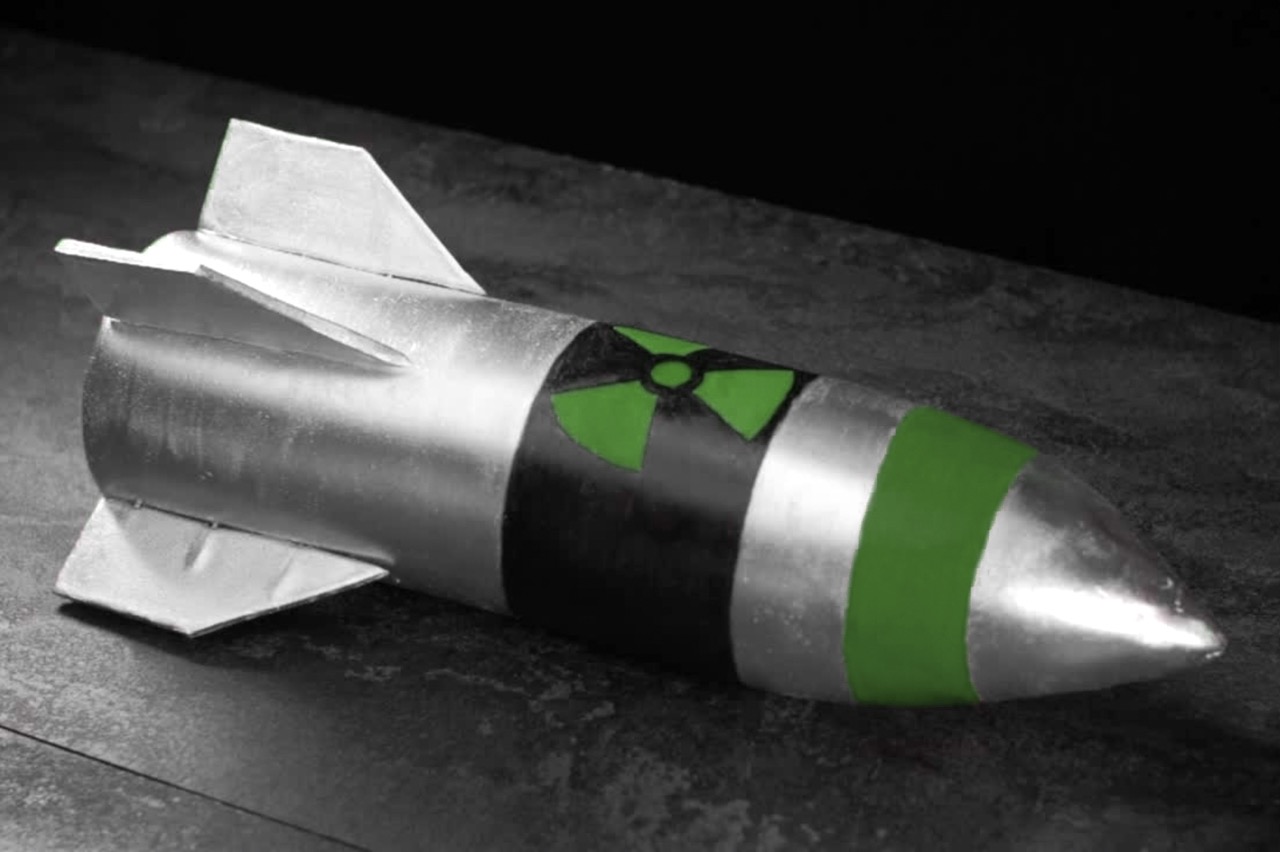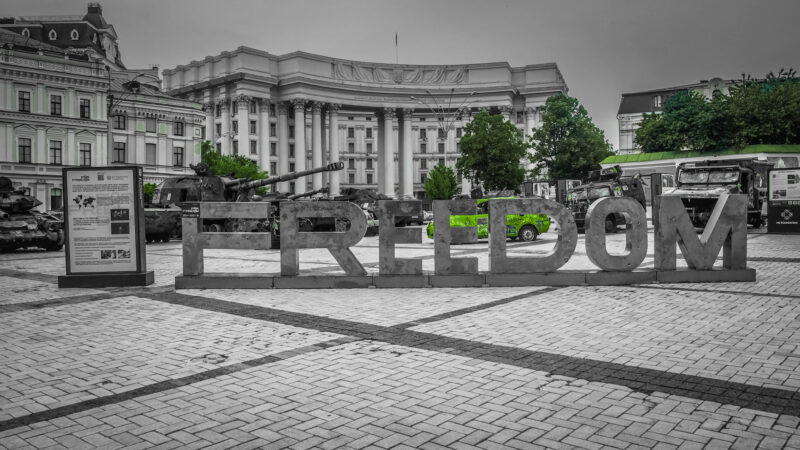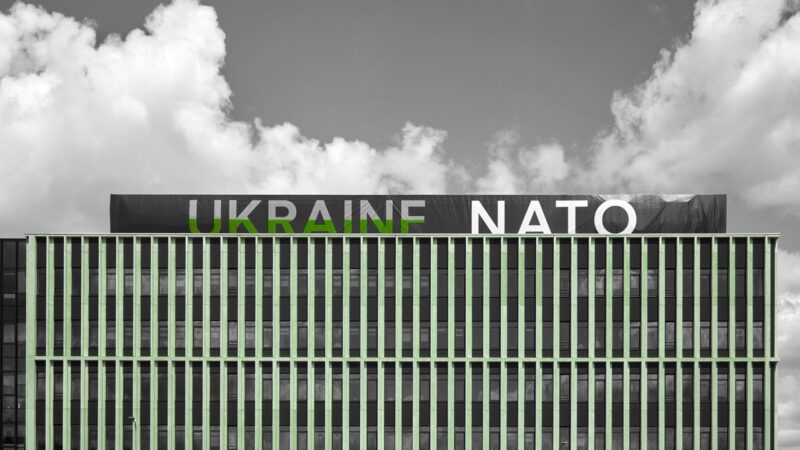Russia’s Disinformation Goes Nuclear

Prior to the escalated invasion of Ukraine, the political and military leadership of the Russian Federation alleged that Ukraine was planning to regain its nuclear status and that it would be receiving the help of Western countries. This claim was repeated on 9 May 2022, almost three months following the 24 February incursion, during the closely watched Victory Day speech by Russia’s President Vladimir Putin. He declared that Russia could not tolerate Ukraine becoming a nuclear state in its “near abroad” and was forced to take steps to prevent it. These false accusations have been repeatedly refuted by Ukraine, the US, and other Western nations; nevertheless, Moscow continues to disseminate them to Russian and international audiences. Essentially, this should be regarded as one of numerous forms of Russian disinformation that are designed to justify its unprovoked invasion of Ukraine and maintain domestic and international support for an illegal military operation that has been floundering.
Russia continues to push false narratives
Russia perpetuates three types of false narratives on nuclear and radiological weapons in Ukraine: (i) Ukraine has nuclear weapons aspirations; (ii) it has ready technical capabilities to produce a nuclear or radioactive device of some sort; and (iii) it is benefitting from Western assistance. These three allegations are examined below in greater detail.
(i) Political will to acquire nuclear weapons
First, by distorting statements made by Ukrainian leaders Moscow alleges that the political will exists for Ukraine to return to its nuclear status. It is true, of course, that Ukraine’s leaders have repeatedly expressed dissatisfaction with the 1994 Budapest Memorandum on Security Assurances, which formalized the new state giving up the Soviet nuclear weapons on its territory and declaring its non-nuclear status. Russian media has recently picked up on such statements and often quotes them out of context to suggest that Ukraine is seeking nuclear weapons capability. To be sure, as far back as 2003 respectable Ukrainian publications aired discussions of nuclear status being the only way to protect Ukraine from foreign aggression—primarily, Russia. Russian media emphasized that the first Ukrainian President, Leonid Kravchuk, who was directly involved in the negotiations on the 1994 Memorandum, said in a series of interviews that Ukraine gave up its nuclear arsenal under immense pressure.
Russian media repeatedly refers to Ukrainian President Zelensky’s speech at the 2022 Munich Security Conference. In this speech, he expressed concerns that Ukraine had given up nuclear weapons for nothing as the security guarantees received from other countries, including Russia, might have never materialized. Russian media published headlines, misinterpreting these words as if Ukraine had threatened the world with nuclear weapons.
Russia’s misleading and distorting narratives are based on extracting these quotes from Ukrainian and Western media to give them a patina of legitimacy. Countering false claims and putting circumstances in context takes time and energy to set the record straight. Ukrainian and Western leaders’ refutations of false claims about Ukraine’s nuclear ambitions sometimes make them seem defensive and divert attention from Russia’s aggressive behavior towards neighboring nations that are charting independent and democratic political pathways.
Technical capabilities
Russian military and intelligence leaders alleged that Ukraine currently has or can quickly regain the technical capabilities to create a weapon of mass destruction: if not a nuclear bomb, then at least a radiological bomb. During Russia’s Security Council meeting on February 21, 2022, Russian Minister of Defense Sergey Shoigu listed the arguments for how Ukraine could acquire such capabilities quickly, especially if it had extensive Western aid. On March 3, 2022, the Director of the Foreign Intelligence Service of Russia, Sergey Naryshkin, claimed to have evidence of Ukrainian efforts to build nuclear weapons. Russia’s political and military leaders have talked about some old Soviet capabilities, such as the Tochka-U missile, which could carry a nuclear payload. The explosions at the Zaporizhzhia nuclear plant and the physics campus of Kharkiv university were also discussed in Russian media. Russia alleged that Ukrainian forces attacked these facilities to hide any traces of the development of nuclear capabilities. On the contrary, multiple credible sources revealed that the Russian military was responsible for the attacks on the Zaporizhzhia nuclear power plant, not Ukrainian forces.
These allegations are nothing new. Russian concerns about Ukraine’s developing nuclear capabilities were repeatedly voiced in 2014 during Russia’s annexation of Ukrainian territory. After Russia’s first invasion of Ukraine, TASS published an interview with experts claiming that Ukraine would be able to develop nuclear weapons in ten years. In a contradictory and condemnatory fashion, Russian media also criticized the idea that Ukraine would even be capable of developing it. Instead, many Russian outlets snidely asserted that Ukraine could not produce a nuclear weapon and could only create a radiological weapon or so-called “dirty bomb.” Russian media called this type of weapon a “poor man’s atomic bomb” and emphasized the ease with which Ukraine would be able to convert its existing limited capabilities to develop it. In 2015, the Russian publication Military Review discussed the history of the dirty bomb concept and concluded that Ukraine would be highly capable of creating them on its territory. There is no evidence that the Ukrainian military or energy authorities have ever pursued the development of radiological weapons in any form.
International support
Finally, the third line of argumentation centers around the claim that the West, both politically and financially, incentivizes Ukraine to develop nuclear weapons as a means to threaten Russia. An article in a Russian military journal, Military-Industrial Courier, talked in 2018 about how China might supply the technology and Saudi Arabia might provide money for the research that can enable Ukraine to develop a “dirty bomb” or even a nuclear weapon.
A possible reason why these claims may seem plausible to Russian audiences is that Russia and Ukraine have a long history of joint work on nuclear capabilities during the Soviet era. Ukrainian research institutions, particularly the above-mentioned Kharkiv institute, played a crucial role in developing Soviet weapons. Russian media openly acknowledged the contribution of the Kharkiv institute in their publications on the topic. A design bureau in Dnipro (Konstruktors’ke byuro “Pivdenne”) was also central to the Soviet intercontinental ballistic missile program. Russia’s disinformation narratives claim that Ukraine’s missile production capabilities serve as evidence of its ability to produce launch vehicles for nuclear warheads. This ignores how producing missiles is fundamentally different from producing nuclear weapons. The Russian claim that missile production equaled an intentional effort to also load the missile with nuclear weapons was pernicious conjecture on their part.
Russian leaders make the strategic argument that they cannot accept Ukraine as a nuclear-armed neighbor because nuclear weapons launched from its territory would strike Russia in a few minutes. The Levada Center’s polls show that, over the past years, the fear of imminent global war has been increasing among Russians. Ukraine is portrayed as a Western proxy, deprived of any decision-making ability and yet capable of inflicting a devastating nuclear strike on Russia.
Why these narratives lack grounds
Political will
Ukrainian rhetoric on dissatisfaction with the Budapest Memorandum and renunciation of its nuclear status can be tracked throughout Ukraine’s history as an independent state. Some of the statements that have received considerable media attention in Russia can be attributed to extremist political groups originating from fringe individuals and organizations that lack legitimacy, both in Ukraine and abroad. Despite numerous attempts to enter mainstream politics, these groups have little electoral support among Ukrainian voters. Therefore, their rhetoric cannot be rightfully interpreted as representing the majority opinion, nor, moreover, can it serve as evidence of Ukraine’s national political objective.
In instances where statements have been made by legitimate Ukrainian political and community leaders, a closer look at the timing of such statements shows that in most cases they were made in response to increased threats from the Russian Federation to Ukraine’s sovereignty and territorial integrity. For instance, Russia’s construction of a dam in the Kerch Strait in close proximity to Ukraine’s territory was one of the early incidents which forced Ukrainian leaders to question the support guaranteed by the Budapest Memorandum.
The annexation of Crimea in 2014 led to even more frequent claims that renunciation of Ukraine’s nuclear status was a mistake, as it did not increase the country’s security. Since 2014 Ukraine has asked for consultations on the Budapest Memorandum four times. They never happened, because Moscow repeatedly blocked the meeting.
Furthermore, Russia’s military buildups over recent years provided Ukrainians rational reasons to express regrets about the renunciation of Ukraine’s nuclear status; some of these regrets were expressed by members of the Ukrainian parliament. However, the many attempts to revive the Budapest Memorandum through consultations occurred during Zelensky’s presidency, which underscores the current Ukrainian government’s commitment to its non-nuclear status. While the Ukrainian government is upholding its commitment, it wants Russia and the other parties involved in the Memorandum to uphold their commitments.
Ukrainian presidents Poroshenko and Zelensky made desperate pleas to revive the international assurance mechanism and expressed disappointment that it had not been working properly. Trust in the Budapest Memorandum was explicitly stated even in the Military Doctrine of Ukraine, adopted in 2012—before Russia’s first invasion of Ukraine. The military and national security doctrines that were passed after the territorial integrity of Ukraine was violated did not express such hope. Notably, even despite the Russian annexation of Ukrainian territory, these documents do not refer in any way to revival of the country’s nuclear status.
Technological capabilities
Russian claims that Ukraine has—or could easily get—the technological capabilities to quickly build nuclear—or at least radiological, weapons—ignoring the fact that even if it wanted to build one, Ukraine would need to make an extraordinary effort to produce a nuclear weapon. Ukraine’s civilian nuclear energy facilities do not possess the necessary technology for producing the fuel required for building a nuclear bomb. Neither does it possess any existing stockpiles of highly enriched uranium. To make a weapon, Ukraine would need to import the necessary enriched uranium or plutonium from another country. After Ukraine eliminated its nuclear arsenal and infrastructure by 2001, 234 kilograms of enriched uranium remained in Ukrainian labs. Then, in 2010 during the Nuclear Security Summit Ukraine decided to give up that nuclear fuel and transferred it in 2012 to the US as a sign of goodwill.
Ukraine does engage in the extraction of natural uranium (which usually consists of 0.03 percent of the mined ore) and processes it into uranium concentrate. However, it does not have the capability to enrich uranium and purchases the nuclear fuel used in its own nuclear power plants from international suppliers. Ukraine has fifteen reactors (13 VVER-1000 and 2 VVER-440) that operate with uranium fuel, enriched up to the level of 3–3.5 percent. It was provided to Ukraine by Westinghouse and Rosatom before the war. These suppliers can use either Ukrainian uranium, enriched to the needed level, or buy it in an already enriched form from an enriched uranium supplier such as the French company Areva.
There was never a uranium enrichment capability in Ukraine during the Soviet times; this was one of the technical reasons that Ukraine gave up the nuclear weapons it inherited from the collapsed USSR. In 2009, when the issue of energy independence from Russia first became relevant for Ukraine, the initiative of President Yusсhenko to introduce uranium enrichment for non-military nuclear energy purposes was discouraged by Western partners. Partly due to Iran’s example of using a civilian nuclear program as cover to develop uranium enrichment capability that is also applicable to weapons programs, uranium enrichment is today of great international concern. If a country can enrich uranium for nuclear reactors, then it has the potential to sooner or later also enrich it to highly enriched uranium or weapons-grade material.
Therefore, since Ukraine does not have any enrichment capabilities to obtain weapons-grade uranium, it would need to establish new capabilities, thereby violating IAEA safeguards. According to many expert assessments, Ukraine would need thousands of centrifuges to produce sufficient highly enriched nuclear material for a nuclear weapon. But Ukraine has signed and ratified the Additional Protocol, which gives the IAEA expanded rights to conduct inspections in order to verify a country’s legitimate retention of nuclear material and verify that there is no prohibited radioactive material. Given that, it would be extremely risky for Ukraine to launch a covert nuclear program, and extraordinary effort would be required to initiate a new enrichment program now without being detected. Moreover, in order to do so Ukraine would need to violate international export controls and the highly enriched material clandestinely. Today, there is a high likelihood of this clandestine effort being detected. Since Ukraine is focused on obtaining conventional weapons to help it counter the Russian invasion, it is highly unlikely that it would risk Western support for its conventional defences by embarking on a long-term risky effort to develop nuclear weapons capability.
Russian false narratives alleging Ukraine’s radiological weapons capabilities highlight that Ukraine uses nuclear power and produces spent nuclear fuel that could be dispersed with conventional explosives, creating a so-called “dirty bomb.” While theoretically possible, handling radioactive material and dispersing it with conventional explosives is very complicated, which partly explains why it has never been done. Highly radioactive spent reactor fuel is stored in a water-cooling pool to lower its radiation level and eventually packed in heavy concrete containers for lasting storage. Even if some amount of spent nuclear fuel is obtained clandestinely, handling highly radioactive material remains a formidable challenge. To keep a human being safe, one kilogram of lead covering is needed for each gram of gamma radiation-producing material. Thus, a bomb containing 5 kilograms of gamma-radioactive material would weigh 5 tons.
Last but not least is the danger of a nuclear reactor blowing up, which could lead to the dispersion of radioactive material over a territory of unknown size. Given Ukraine’s experience with and continuing custodianship of the Soviet-era reactor at Chornobyl, Ukraine is not likely to risk another nuclear industrial incident of this type on its territory. However, Russia’s military attacks on the Zaporizhia Nuclear Power Plant entail a serious possibility of creating just this type of radiological incident. Ukrainian reactor management officials moved 200 metric tons of spent fuel containers at the reactor so that they could be monitored by overhead satellites, in order to detect any attempts to move them further, which would require special transport capabilities in order to do so safely.
International support
Russia’s narratives on Ukraine building a nuclear or a radiological weapon to target Russia include a reference to external support. This false argument plays the most to the fears of Russia’s domestic audiences. Western leaders explicitly and repeatedly refute this claim. While some Ukrainians have argued that nuclear capability would protect it from Russia, Ukraine’s elected leadership has been extremely cautious about not stoking Russian fears.
Given the IAEA inspection provisions under the Additional Protocol, the cost of a clandestine nuclear program and the risk of it being detected are significant disincentives for Ukraine to pursue nuclear weapons capability today. Moreover, the international political costs of secretly pursuing nuclear capability after having committed not to do so would threaten Ukraine’s relations with Western partners and would inevitably undermine one of the main pillars of the country’s foreign policy since 2014. Notably, while a legislative bill on Ukraine’s withdrawal from the Nonproliferation Treaty was registered back in 2014, it never received serious consideration. In sum, underscoring once again, Ukraine accepted the obligations of the Additional Protocol’s comprehensive safeguards agreement, which entails “the highest level of trust of the Agency to the state.” The IAEA regularly checks all the nuclear facilities in Ukraine, including the Neutrons Source Facility in Kharkiv—which Russia often falsely claims is the main source of Ukraine’s “nuclear program.” SIPRI Research Associate Peter Topychkanov has stated that there have never been concerns associated with Ukraine regarding any prohibited nuclear activities. Neither the IAEA nor any other actor other than Russia have ever claimed that Ukraine was developing a clandestine nuclear program. Russia’s false accusations about Ukraine’s desire to obtain nuclear weapons capability are just part of its information warfare, which aims to justify the invasion and maintain support for its invasion of Ukraine with Russian domestic and foreign pro-Russian audiences.





